Grow these seven edible border plants to delight both bees and your palate: lavender, sunflowers, borage, rosemary, nasturtiums, bee balm, and calendula. You’ll create a stunning garden boundary that attracts essential pollinators while providing ingredients for your kitchen. Each plant offers unique flavors—from lavender’s floral notes to nasturtiums’ peppery kick—while requiring minimal maintenance. Discover how these multitasking plants can transform your garden into a buzzing ecosystem that feeds both wildlife and your family.
Lavender: The Fragrant Bee Magnet With Culinary Magic
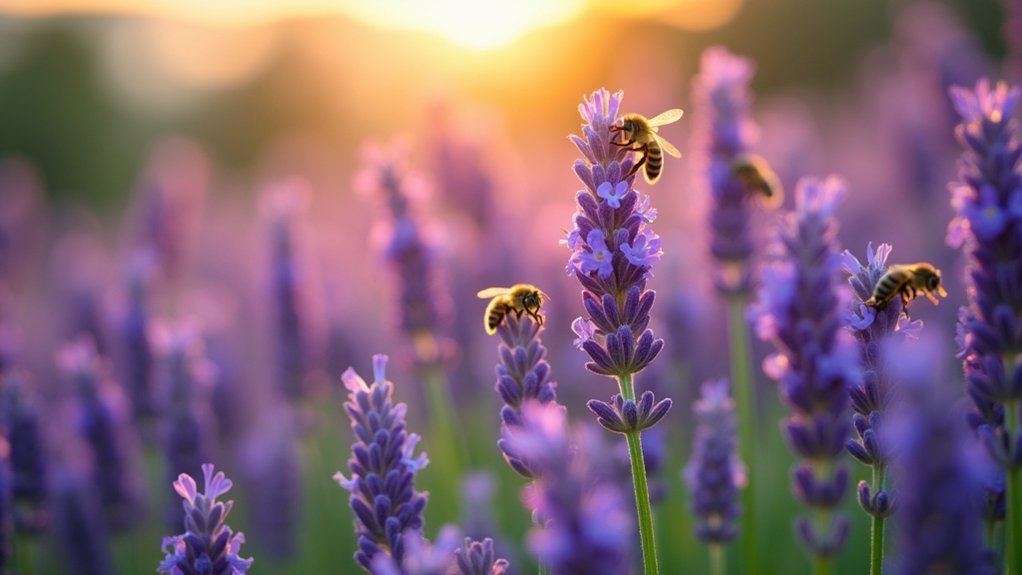
While creating the perfect edible border garden, you’ll find few plants as versatile as lavender—a powerhouse for both bees and your kitchen. This aromatic herb acts as a bee superhighway, providing abundant nectar from mid-summer through fall when these pollinators need it most.
You’ll love how lavender pulls double duty in your landscape. Its culinary applications range from flavoring savory dishes to brewing calming teas, making it practical beyond its ornamental value.
What’s more, this low maintenance perennial thrives in various garden conditions with minimal care.
When you plant lavender in your borders, you’re not just creating an attract bees zone—you’re fostering an entire ecosystem. The diverse insects it welcomes contribute to a balanced garden environment that benefits all your edible plants through improved pollination and natural pest control.
Sunflowers: Towering Edible Beauties That Bees Cannot Resist
Your garden’s borders can become pollination powerhouses when you plant sunflowers, which produce abundant nectar and pollen that bees simply can’t resist.
Different varieties like the Lemon Queen offer unique benefits, producing up to twenty blooms from a single plant and maximizing your garden’s bee-feeding potential.
You’ll find these towering beauties serve double duty – providing edible seeds for your kitchen while creating essential habitat that supports diverse pollinator populations throughout the growing season.
Pollination Powerhouse Plants
Sentinels of summer gardens, sunflowers stand as nature’s perfect pollinator magnets while offering both beauty and bounty to your landscape.
As true pollination powerhouse plants, they’re irresistible to bees seeking nutrient-rich food sources.
The Lemon Queen variety exemplifies why bees love these golden giants—producing up to twenty blooms from a single seed and providing abundant nectar and pollen throughout the season.
You’ll find both honey bees and native species flocking to these accessible, open flowers.
What makes sunflowers exceptional plants for bees is their combination of ease and efficiency.
They thrive in full sun with minimal care, while their deep root systems improve your soil’s health.
Multiple Variety Benefits
Many gardeners who embrace diverse sunflower varieties discover benefits far beyond simple beauty. You’ll find the Lemon Queen particularly impressive, producing up to twenty flowers from a single seed—creating an efficient nectar source that bees simply can’t resist.
These edible towering beauties serve dual purposes in your garden borders. They provide critical forage for honey bees and native pollinators while thriving in various soil conditions. By clustering different sunflower varieties together, you’ll greatly enhance your garden’s attractiveness to bees compared to isolated plantings.
Beyond attracting beneficial insects, sunflowers actively remediate soil, improving your garden’s overall ecosystem health. Their robust nature makes them accessible even for novice gardeners, ensuring your borders can easily become pollinator havens while providing edible seeds for your kitchen.
Borage: Blue Stars That Delight Both Bees And Salads
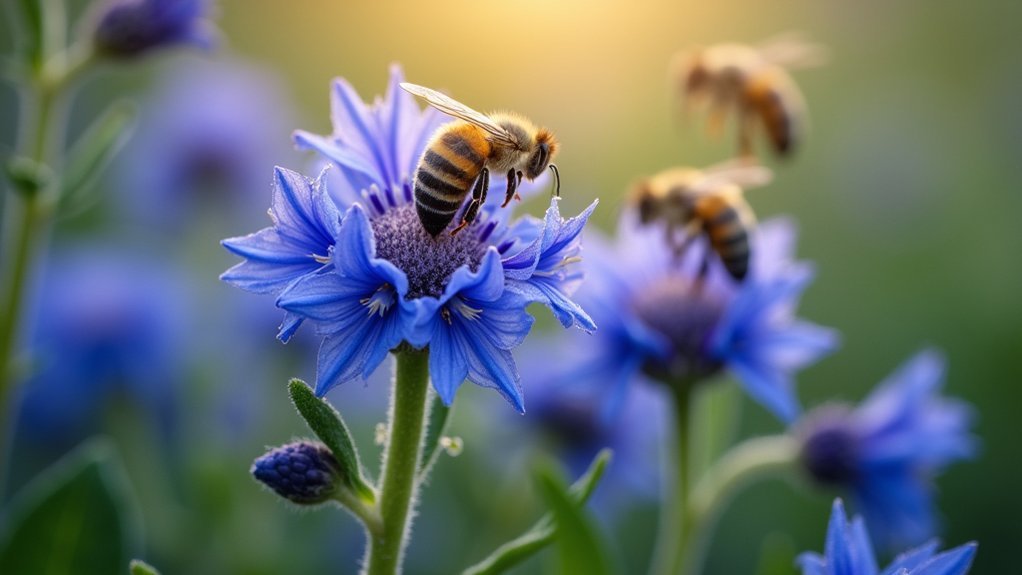
Azure stars dance across the garden as borage (Borago officinalis) unfurls its stunning blue flowers, creating an irresistible beacon for passing bees. This remarkable plant serves as both pollinator paradise and culinary treasure, offering a continuous supply of nectar throughout summer months when bees need it most.
You’ll love how easily borage grows in your garden borders, thriving even in poor soil conditions where other plants struggle. The star-shaped flowers don’t just attract bees—they’re edible too, adding a revitalizing cucumber flavor to your summer salads and drinks.
Beyond feeding pollinators and your family, borage works silently to improve your garden ecosystem, enriching surrounding soil and enhancing the growth of neighboring plants.
Borage silently nourishes your garden, transforming soil and elevating companion plants with its generous nature.
It’s truly a multitasking border plant that requires minimal care while delivering maximum benefits.
Rosemary: Aromatic Hedge That Feeds Pollinators Year-Round
Evergreen spires of rosemary stand as living fences in garden borders, offering bees a reliable food source when other plants have long stopped flowering.
You’ll notice constant buzzing around its fragrant blue blooms that appear from late winter through spring, providing critical early-season nectar for hungry pollinators.
This versatile herb thrives in various garden conditions, making it perfect for your edible landscape.
As an aromatic hedge, rosemary delivers a double benefit – enhancing your garden’s appearance while creating habitat for beneficial insects.
The steady bee traffic attracted to your rosemary will improve pollination throughout your garden’s edible plants.
Plant rosemary along pathways or as border plants where you can easily harvest its flavorful sprigs for cooking while supporting a thriving ecosystem in your garden.
Nasturtiums: Peppery Blooms That Create A Buzzing Boundary
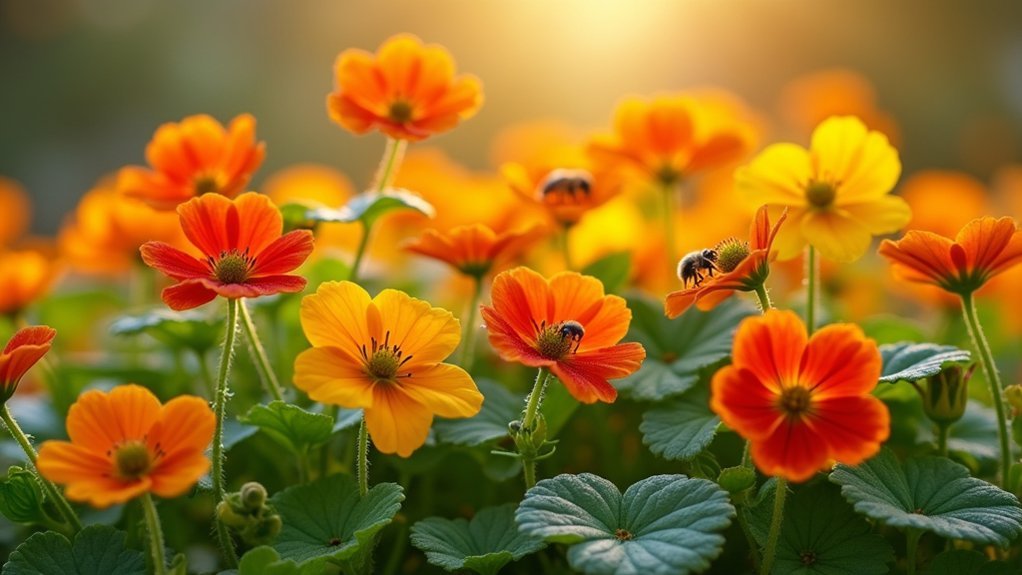
Trailing across garden borders with their vibrant disc-shaped leaves and trumpet flowers, nasturtiums create a living tapestry that bees simply can’t resist.
These bee-friendly plants thrive in poor soil conditions, making them perfect for those challenging spots in your garden where other edibles might struggle.
Embrace nasturtiums as nature’s solution for those stubborn garden patches where fussier plants simply give up.
You’ll love how nasturtiums pull double duty—their peppery flowers and leaves are entirely edible for you, while their abundant nectar attracts pollinators that benefit your entire garden.
Plant them in full sun or partial shade along borders, and they’ll reward you by deterring aphids naturally.
Growing nasturtiums from seed couldn’t be easier, requiring minimal maintenance while providing maximum impact.
Their ability to attract bees while repelling pests makes them an essential addition to any edible landscape’s boundaries.
Bee Balm: The Pollinator Paradise With Tea-Making Potential
Standing tall along garden borders, Bee Balm creates a spectacular display that transforms your landscape into a pollinator paradise. This versatile herb thrives in full sun to partial shade, reaching heights of 1-4 feet with a spread of 1-3 feet. You’ll love how it attracts bees, butterflies, and hummingbirds with its tubular, vibrant flowers.
| Benefits | Garden Use | Harvest Tips |
|---|---|---|
| Attracts pollinators | Perfect herb garden addition | Pick leaves before flowering |
| Makes aromatic tea | Creates colorful borders | Harvest mid-morning |
| Supports biodiversity | Fills sunny spots beautifully | Dry upside down in bunches |
| Enhances ecosystem | Pairs with other flowers for bees | Use fresh or dried for tea |
| Provides nectar source | Adaptable to many soils | Regular cutting encourages growth |
Beyond its beauty, you’re cultivating a beneficial habitat while growing your own tea source—ecological gardening at its finest.
Calendula: Golden Border Flowers From Garden To Plate
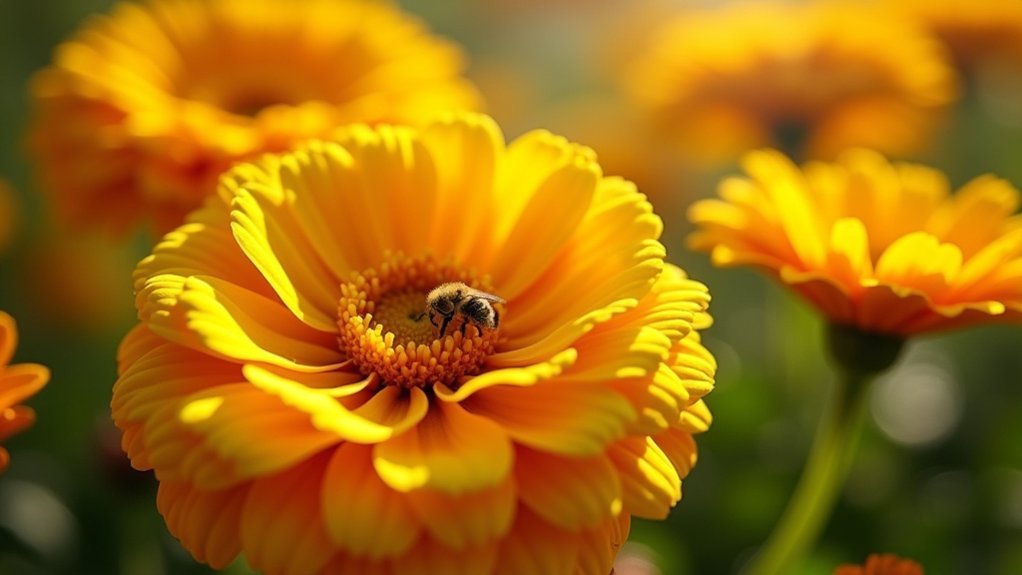
Calendula’s vibrant orange and yellow blooms will transform your garden borders into buzzing pollinator havens while providing a steady supply of edible flowers for your kitchen creations.
You’ll find these golden beauties remarkably easy to grow in well-drained soil with full sun exposure, making them perfect for novice and experienced gardeners alike.
With proper care and successive plantings, you can enjoy calendula’s bee-supporting benefits nearly year-round in milder climates, extending both your harvesting season and the nectar supply for local pollinators.
Vibrant Pollinator Magnets
Sunshine captured in petal form, calendula stands as one of the most rewarding border plants for both bees and gardeners alike.
These golden blossoms don’t just brighten your garden—they’re serious pollen and nectar powerhouses that honey bees can’t resist. You’ll appreciate how these Plants that Attract pollinators keep working from early spring through late fall.
What makes calendula particularly valuable for your pollinator garden:
- They’re incredibly easy to grow, thriving even in poor soil conditions while requiring minimal maintenance.
- Their edible petals serve double duty in your kitchen and as natural dyes.
- Their continuous blooming habit guarantees bees have a reliable food source throughout the growing season.
Easy Kitchen Garden Addition
The magic of calendula extends well beyond its bee-attracting powers into your kitchen repertoire. This versatile plant is the perfect addition to the garden, thriving in various soil types while producing edible petals that brighten salads, soups, and garnishes with their mild flavor.
Bees absolutely love calendula’s continuous nectar flow from early spring through late fall, making it a pollinator powerhouse. You’ll appreciate how easily these golden blooms establish themselves, returning year after year if you allow some flowers to set seed.
Beyond their culinary uses, calendula offers medicinal benefits with anti-inflammatory and healing properties. By planting these vibrant pot marigolds in your kitchen garden borders, you’re creating a multi-purpose space that nourishes both pollinators and your own plate.
Year-Round Growing Potential
While other flowering plants retreat during cooler seasons, calendula offers remarkable growing potential throughout much of the year, especially in milder climates.
If you spend some time planning your planting schedule, you’ll enjoy these golden blooms from early spring well into late fall.
To maximize your calendula’s extended growing season:
- Plant in well-draining soil with staggered sowing times every 2-3 weeks
- Choose a variety of edible cultivars with different maturation rates
- Deadhead regularly to encourage your plant flowers to continue blooming
This continuous flowering cycle not only beautifies your garden borders but provides an uninterrupted nectar source for bees and other pollinators.
Frequently Asked Questions
What Plant Do Bees Love the Most?
You’ll find bees adore lavender most intensely. They’re drawn to its fragrant purple blooms rich in nectar. Sunflowers and borage also attract them strongly with their abundant pollen and nectar offerings.
What Edible Plants Are Good for Bees?
You’ll find bees thrive on herbs like basil, lavender, and chives. They’re drawn to flowering vegetables including zucchini, cucumber, kale, and broccoli. Borage is another fantastic edible that bees absolutely can’t resist.
What Is a Bee Hummingbird’s Favorite Flower?
Bee hummingbirds particularly favor tubular flowers in red, orange, and pink. You’ll find they’re drawn to penstemon, trumpet vine, salvia, and columbine for their easy nectar access and bright, vivid colors.
What Food Are Bees Most Attracted To?
Bees are most attracted to flowers rich in nectar and pollen. You’ll find they love lavender, borage, dandelions, herbs like rosemary, and flowering edibles such as zucchini, cucumbers, and berry plants.
In Summary
You’ve discovered the perfect win-win for your garden—plants that create beautiful borders, provide tasty additions to your meals, and support essential pollinators. By incorporating these seven bee-friendly edibles, you’re not just enhancing your landscape but also helping local ecosystems thrive. Plant them in sunny spots, water appropriately, and you’ll soon enjoy both the buzzing activity and the delicious harvests they provide throughout the growing season.

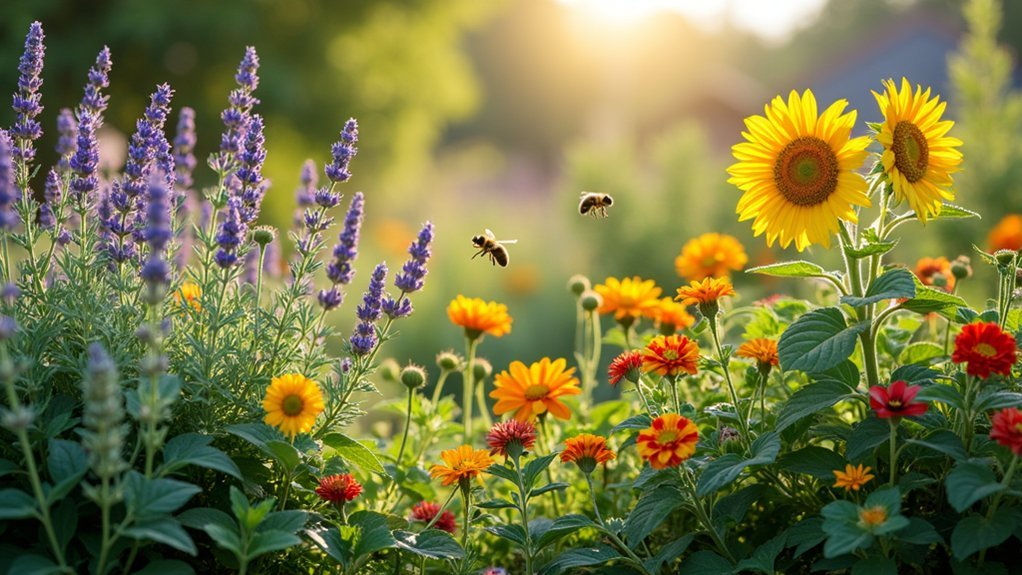



Leave a Reply